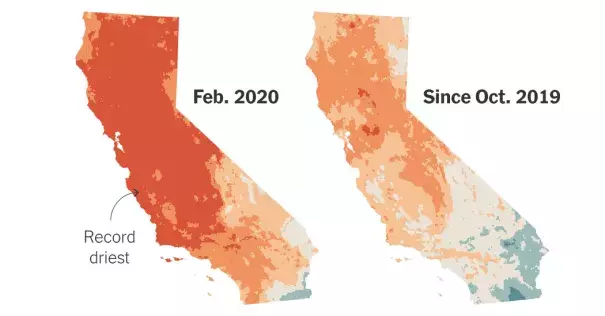California Had Its Driest February on Record. Here’s How Bad It Was.

Climate Signals Summary: Climate change is increasing temperatures and the amount of precipitation that falls as rain rather than snow, both of which contribute to California snowpack decline. Climate change may also be changing weather patterns leading to less precipitation in California. All of these factors increases drought risk and wildfire risk in the state.
Article Excerpt: Not a drop of rain fell in downtown San Francisco this February. Or in Big Sur State Park. Or in Paso Robles. February in California was so dry that it is raising concerns that the state, which, according to the National Drought Mitigation Center, only fully emerged from drought last March, may be headed for another one.
“It was the driest February on record,” said Daniel Swain, a climate scientist with the Institute of the Environment and Sustainability at the University of California, Los Angeles.
...
But this February “was not just merely a below average month,” Dr. Swain said. “It was, in a lot of places, a completely dry month, which is truly extraordinary.”
The lack of snow and rain in February comes after a January that was also drier than average, and a record dry autumn for much of Northern California. A series of storms dumped a considerable amount of snow in late December, raising hopes that this winter might proceed normally. But that now seems less likely.
...
The United States Drought Monitor, a joint project by federal agencies, including the National Oceanic and Atmospheric Administration and the Department of Agriculture, releases drought maps weekly. They currently show much of the state as either abnormally dry or in moderate drought.
As of March 1, according to the California Department of Water Resources, the state’s snowpack was 44 percent of normal. In the Southern Sierras, the percentage was only 40 percent.
...
The lack of moisture is coming at a time when the state needs more water, not less. January and February weren’t just unusually dry, they were also unusually warm. On Feb. 27, for example, the temperature at the Los Angeles International Airport hit 85 degrees Fahrenheit, or about 29 Celsius, breaking a record of 83 degrees Fahrenheit that was set in 1992.
“In recent weeks there have actually been a number of days with spring or even summer-like temperatures in the 70s and 80s throughout a lot of California, which were daily record high temperatures for a portion of February,” Dr. Swain said.
The hotter temperatures, which are associated with climate change, dry out soil, making moisture less available to plants and increasing wildfire risk. The state has already seen an uptick in reported fires, according to The California Department of Forestry and Fire Protection, or CalFire, which responds to reports of wildfires.
Related Content



